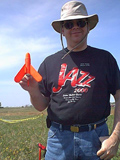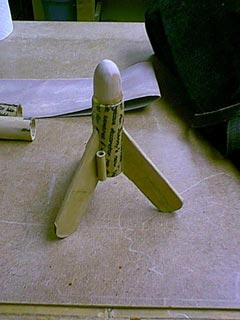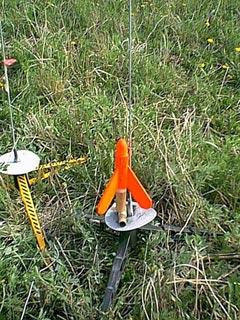Scratch Ugly Bug Original Design / Scratch Built
Scratch - Ugly Bug {Scratch}
Contributed by John Nordlie
| Manufacturer: | Scratch |
 Brief:
Brief:
My first true 'scratch-built' model rocket was the Ugly Bug. It is based on the Estes Mosquito, but built for an Estes 'D' (24mm) motor rather than the standard mini-motor. This is actually not the first time I've built a scaled-up Mosquito, but I don't really count the first time as a rocket. Back in grad school a fellow student who had never seen a model rocket was curious about them. I didn't have any built models, but did have a spare D booster motor sitting around and had an idea. We added some balsa fins, a wooden nose cone, and a launch lug made from paper and glue formed on a drill bit. This little assembly went like stink off the pad and we promptly lost track of it. We found it sitting in the parking lot later, and the other grad student repainted it, plugged the burned-out motor with glue, and hung it on the wall of his office.
Years later, I was working on a true scaled-up Mosquito design about 14" in length with a full parachute recovery system. However, I wasn't finished with it by the time a NDRA launch came around. Not wanting to bring only mundane models to the launch, I decided on a Thursday night that I should build another of the 'flying motor' D birds to get rid of some D12-3 motors I had. The delay on these was too short for my only D rocket at the time, so they seemed good candidates for glued-on fins. Part-way into building the first one, I thought, "Heck, why go to all this trouble when I could add a body tube and have a real, reusable rocket?" Thus the Ugly Bug project was born.
 Construction:
Construction:
It was Thursday night, and the launch was Saturday morning. I had less than 48 hours to actually build a rocket. "No problem," I figured, "I'll just use whatever I can find and keep it super-simple." Since I had no actual kit parts, I'd have to scrounge and scratch-build everything. I decided to keep to the original Mosquito recovery system, which is 'featherweight'. This means the rocket ejects its spent motor and is so light it won't be harmed by the fall. This works fine for a model barely bigger than a mini-motor, but looking back on it, it was probably wishful thinking for a D bird. In any case, I started scrounging around the garbage and my rocket shop and gathered the needed materials.
For the bigger scaled-up Mosquito, I had been toying with the idea of using corrugated cardboard wrapped in paper that had been soaked with wood glue (sort of like a composite structure without using fiberglass and resin). I had gone as far a building a test piece with this method, but had concluded it probably wasn't strong enough to build the large fins of the 14" Mosquito. However, the test piece was the perfect size to cut three fins out of for the Ugly Bug. I used the TLAR (That Looks About Right) engineering method to determine fin size and shape, cut them out and sanded them to profile. Now some form of body tube was needed. I located a hunk of dowel just slightly larger than the 24mm D motor to use for the nose cone, and decided to use it as the form for building a body tube. Back to the garbage for an old brown paper sack. I cut a strip of this, rubbed it with yellow wood glue, and rolled it on to the dowel (which I had protected with a wrap of plastic sheet to keep the glue from sticking). After the tube was formed and rolled to remove excess glue, I slipped it off the form and set it aside to dry.
Next I sanded one end of the dowel to a nose-like shape using a belt sander. After a bit of finishing hand-sanding, I used a bandsaw to cut the end off, leaving a 1/2" straight section for gluing into the body tube. Finally, I formed a launch lug out of more brown paper soaked with glue and wrapped around a drill bit. All these were set out to dry overnight.
The next day, I used the bandsaw again to trim the ends of the tubes square and clean. I used a D motor to measure how long the body needed to be, and trimmed it again. Then all the parts were glued together and left to dry.
Finishing:
Now is when the name of the rocket suggested itself. Definitely not my finest
work, but it would do for a 'throw away' rocket. When the glue had dried, I
applied three coats of blaze orange spray paint. If you've ever flown a
Mosquito, you know how easy it is to lose them. I figured the paint was the
only color that gave it a fighting chance of being found. It took until 1:30 am
that night, and the use of a hair dryer to speed drying, but I finished the
Ugly Bug and went to bed.
 Flight:
Flight:
I had to build up some masking tape on the D motor to get it to fit inside the body properly. Not having a recovery system or motor retention really simplified design and building, but if I did it again I'd include a streamer for safety.
The first flight on a D12-3 went as I expected: the rocket shot off the pad to a very impressive altitude, the ejection charged popped the motor out in a puff of smoke, and the rocket vanished into the blue sky. The Range Safety Officer wasn't entirely impressed with this, but knew the chances of it actually hitting someone and hurting them was very low. We launched other rockets, then went looking for the UB. Incredibly, it was found about 1/2 mile from the launch site. One fin had broken off on landing, but was easily reattached with some quick-drying glue. Two fins had some scorch marks on them where the exhaust gas had burned little holes in the paper covering, but were still structurally strong. The UB was flight worthy again!
I debated if I should just count myself lucky and put the UB on my shelf, but then remembered I had expected to lose the little bugger and it was constructed more for amusement of the spectators than anything else. I therefore decided to fly it again. This time, I wanted to see just how high I could get it to fly. I had just flown my Estes Snitch (plastic saucer) with a chad-staged D12-0, so I figured, "What the heck?" I grabbed my last D12-3, taped it to fit the Ugly Bug, then taped a D12-0 on the tail in the staged configuration:
The burned-out motor lying on its side on the blast plate is being used as a spacer to keep the booster's ignitor from being shorted out. This is (surprise!) the last picture ever taken of the Ugly Bug. Unfortunately, the center of gravity had been moved so far back by the booster that the rocket was unstable during the first bit of its flight. No loops or spins, but the rocket wandered around until most of the booster's propellent had burned out. Just before staging, the CG had moved far enough forward to become stable. At staging, the rocket was nearly horizontal and about 200' high. Staging went fine, and the Ugly Bug shot off in an arc to the north west. At that altitude and speed, the ejection charge puff wasn't visible, and we didn't even bother to go look for the little rocket.
Summary:
Thus was the end of my first scratch-built and aptly-named rocket. The
14" Mosquito is nearly complete, and will be dubbed 'Big Ugly Bug', but
will fly and return to the ground in a much more sane manner
 |
 |